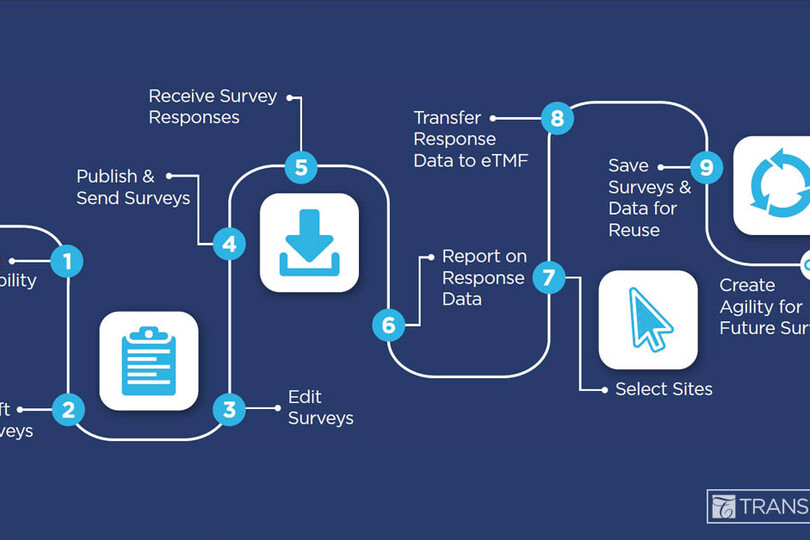Take our TMF Risk Score Survey today!
Site Feasibility
Monday, September 24, 2018 | 3:11 PM

Time for more site feasibility talk!
Last time, we talked about how pharma companies and CROs are recognizing the need for focused electronic feasibility (e-feasibility) solutions to address inefficiencies in the site selection process. Specifically, we discussed the opportunities to automate site questionnaires and the associated response tracking. While these are the obvious gains of e-feasibility, there are many other, more nuanced advantages. One such advantage being simplifying the execution of confidentiality disclosure agreements.
As the product manager for TI E-Feasibility, I have had the opportunity to collaborate with clinical teams and discuss the challenges of site identification through site selection. One of the most commonly referenced topics is confidentiality disclosure agreements (CDA). CDAs bind a site to privacy practices and safeguard billions of dollars spent by a sponsor in discovering a new drug (Mullin, 2014) Which is why CDAs must be fully executed and collected by sponsors/CROs for all sites before any critical and confidential information can be shared. This process may take anywhere between a few weeks to a few months, depending upon the tools and methods deployed by the CRO/ sponsor in this process.
Why is this simple sounding agreement so challenging for clinical teams? Let’s explore through five common CDA pain points:
Ineffective Collaboration and Processes
In some cases, executing a CDA can be a very basic process where the sponsor/CRO and the site agree with the terms and conditions. More often than not there is an extended back and forth as the terms of the CDA are negotiated between parties. Add to this time consuming dialog the complexity of outdated, manual methods of distribution, execution, and collection of CDAs for often anywhere between 50 to 100 sites and is not hard to see where efficiency diminishes. Traditional methods of mail, fax, and emails are used for distributing the CDAs to the sites. The distribution lists to send the CDAs are often manually maintained. You can easily imagine the time it takes to distribute CDAs using any of the above methods for over 250 sites for each study (Hurtado-Chong A, 2017)! It is then not too hard to imagine the time saved by automating these processes with electronic distribution lists (via an Outlook address book integration, for example), which can then seamlessly distribute the CDAs, while maintaining the curtain of privacy between the intended recipients!
Manual Tracking
Once the CDAs are distributed, most CROs and sponsors are still using spreadsheets to track them. At one point, excel was a great tool to improve efficiency. By today’s standards, it is cumbersome. Tracking CDAs by spreadsheet is not only time consuming and inefficient, but prone to human error. A simple mistyped entry creates bad data. Automating this tracking ensures reliable data and makes it easy to review progress through dashboards where CROs and sponsors can create detailed progress reports with just a click of a button. Further automation such as notifications as CDAs are accepted and executed by sites can make it even easier to track the CDAs.
Nuanced Workflows
Another complication in the CDA process is the alternate workflows needed for executing CDAs. For example, in some cases the CROs and sponsors have a previously executed CDA with a site and do not require a new one be created. This simplifies things in a way, but alters the execution process. In another scenario, CDAs might need to be accepted by more than one person from the site, or they may not need to be countersigned by the CRO and sponsor. Again, these small nuances change the execution process. Antiquated tools used by the industry are inadequate to manage these idiosyncrasies with finesse. The ability to easily configure the CDA workflow per the requirement of each study makes it easy to adapt to variance in required workflows.
Negotiation
As mentioned earlier, more often than not the sites do not simply sign on the dotted line. They want to negotiate some terms of the agreement. For example, a site may not be agreeable to certain infrastructure setup required by a CRO. In these situations, a back and forth between the parties begins as the terms are being negotiated. In practice, this discussion translates in to delays of several weeks, if not months! (Iowa State University) If both parties are able to collaborate on an electronic format of the CDA, the entire negotiation time can be reduced to less than a few days by eliminating the constant handoffs and creating a continuous, central workspace to manage the negotiation.
CDA Archiving
Finally, there is the consideration for archiving and retrieving duly executed CDAs. A small CRO might be responsible for managing over 20 studies. If, on an average, 200 sites are approached for each study, the CRO will have to safeguard its interest through something like 4,000 agreements! (Hurtado-Chong A, 2017) Can you even imagine managing that manually? Again, e-feasibility technology can simplify this entire process whereby CDAs can be migrated directly to the electronic trial master file (eTMF).
The distribution, negotiation, execution, tracking, and archiving of CDAs does not need to be so painful. Further integration with other e-clinical applications for study start-up and eTMF further helps teams create a seamless flow of content and data from one step in the study lifecycle to the next. The technology is already here! Why not make life easier?
Want help streamlining your feasibility process, contact us at info@trialinteractive.com





